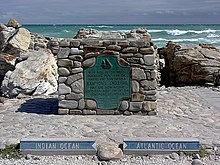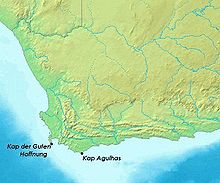Cape Agulhas
Cape Agulhas (Portuguese Cabo das Agulhas for 'Cape of the Needles'; Afrikaans Kaap Agulhas; English Cape Agulhas) is the southernmost point of the African continent, not, as often assumed, the Cape of Good Hope. The 20th meridian, which lies approximately on Cape Agulhas (exactly it runs about 150 m to the east), represents the geographical border between the Atlantic and Indian Oceans.
The continental shelf off the Cape extends 250 kilometres seawards; the waters around the Cape are among the richest in fish on the South African coast.
The first known European navigator to reach Cape Agulhas in 1488 was the Portuguese Bartolomeu Dias. Cabo das Agulhas is Portuguese for 'Cape of the Needles'. The sailors probably gave it the name because of its numerous rocks and reefs. The clash of different ocean currents often leads to high waves, and the waters around Cape Agulhas are considered very dangerous because of this and because of the reefs. Another theory is that in the 15th century the compass needle there pointed exactly to the geographic North Pole, i.e. the magnetic declination was exactly 0°.
Among other things, the warm Agulhas Current, which was first described by Vasco da Gama on his first voyage to India in 1497/98, is named after Cape Agulhas.
· 
The lighthouse at Cape Agulhas
·
Ascent to the upper platform

marker at Cape Agulhas

Africa's southern tip
Trivia
The Agulhas long-billed lark is named after the cape.
See also
- Cap Vert (Western tip of Africa)
- Cape Guardafui (Eastern tip of Africa)
- Ras ben Sakka (northern tip of Africa)

enlarge and show information about the picture
![]()
Panorama from the lighthouse
Search within the encyclopedia
